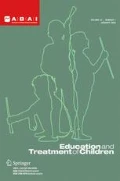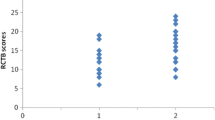Abstract
This study examined the effect of the self-regulated strategy development (SRSD) instructional model on the reading comprehension of elementary students with behavior challenges using a multiple-baseline across students design. Students were taught TRAP (Think before reading, Read the paragraph, Ask yourself what the paragraph is mostly about and what is the most important information, and Paraphrase the paragraph; Mason et al. 2012) mnemonic using the six recursive stages of SRSD. A functional relation between the TRAP intervention and student scores on reading comprehension probes were observed. High treatment fidelity and social validity were reported. Limitations, implications for practitioner use, and directions for future research are discussed.

Similar content being viewed by others
References
Al Otaiba, S., & Fuchs, D. (2002). Characteristics of children who are unresponsive to early literacy intervention: A review of the literature. Remedial and Special Education, 23, 300–316.
Butler, S., Urrutia, K., Buenger, A., Gonzalez, N., Hunt, M., & Eisenhart, C. (2010). A review of the current research on vocabulary instruction. Retrieved from U.S. Department of Education website: Http:// www2.ed.gov/programs/readingfirst/support/compfinal.pdf.
Christ T. J. (2017). FastBridge Learning, Retrieved September 6, 2017, from http://www.fastbridge.org
Cohen, J. (1988). Statistical power analysis for the behavioral sciences (2nd ed.). New York, NY: Lawrence Erlbaum.
Conner, C. M., Alberto, P. A., Compton, D. L., & O’Conner, R. E. (2014). Improving reading outcomes for students with or at risk for reading disabilities: A synthesis of the contributions from the Institute of Education Sciences Research Centers.Retrieved from: https://ies.ed.gov/ncser/pubs/20143000/pdf/20143000.pdf
Gast, D. L., & Ledford, J. R. (2014). Single case research methodology: Applications in special education and behavioral sciences. New York: Routledge.
Gersten, R., Fuchs, L. S., Williams, J. P., & Baker, S. (2001). Teaching reading comprehension strategies to students with learning disabilities: A review of research. Review of Educational Research, 71, 279–320.
Guthrie, J. T., & Davis, M. H. (2003). Motivating struggling readers in middle school through an engagement model of classroom practice. Reading & Writing Quarterly, 19, 59–85.
Hagaman, J. L., Casey, K. J., & Reid, R. (2016). Paraphrasing strategy instruction for struggling readers. Preventing School Failure, 60, 43–52.
Hagaman, J., & Reid, R. (2008). The effects of the paraphrasing strategy on the reading comprehension of middle school students at risk for failure in reading. Remedial and Special Education, 29, 222–234.
Harris, K. R., Graham, S., Mason, L. H., & Friedlander, B. (2008). Powerful writing strategies for all students. Baltimore: Paul H. Brookes Publishing Co., Inc..
Horner, R. H., Carr, E. G., Halle, J., McGee, G., Odom, S., & Wolery, M. (2005). The use of single-subject research to identify evidence-based practice in special education. Exceptional Children, 71, 165–179.
Howorth, S., Lopata, C., Thomeer, M., & Rodgers, J. (2016). Effects of the TWA strategy on expository reading comprehension of students with autism. British Journal of Special Education, 43, 39–59.
Johnson, J. W., Reid, R., & Mason, L. H. (2012). Improving the reading recall of high school students with ADHD. Remedial and Special Education, 33, 258–268.
Kamil, M. L., Borman, G. D., Dole, J., Kral, C. C., Salinger, T., & Torgesen, J. (2008). Improving adolescent literacy: Effective classroom and intervention practices. IES practice guide. NCEE 2008-4027. National Center for education evaluation and regional assistance.Retrieved from https://ies.ed.gov/ncee/wwc/Docs/PracticeGuide/adlit_pg_082608.pdf
Kazdin, A. E. (2011). Single-case research designs: Methods for clinical and applied settings. New York: Oxford University.
Kilgus, S. P., Chafouleas, S. M., Riley-Tillman, T. C., & von der Embse, N. P. (2014). Social, academic, and emotional behavior risk screener (SAEBRS). Minneapolis: Theodore J. Christ & Colleagues.
Klingner, J. K., Urbach, J., Golos, D., Brownell, M., & Menon, S. (2010). Teaching reading in the 21st century: A glimpse at how special education teachers promote reading comprehension. Learning Disability Quarterly, 33(2), 59–74.
Klingner, J. K., Vaugh, S., & Boardman, A. (2015). Teaching reading comprehension to students with learning disabilities. New York: Guilford.
Losinski, M., Cuenca-Carlino, Y., Zablocki, M., & Teagarden, J. (2014). Examining the efficacy of self-regulated strategy development for students with emotional or behavioral disorders: A meta-analysis. Behavioral Disorders, 40, 52–67.
Martin, J. E., Mithaug, D. E., Cox, P., Peterson, L. Y., Van Dycke, J. L., & Cash, M. E. (2003). Increasing self-determination: Teaching students to plan, work, evaluate, and adjust. Exceptional Children, 69, 431–446.
Mason, L. H., & Shriner, J. G. (2008). Self-regulated strategy development instruction for writing an opinion essay: Effects for six students with emotional/behavior disorders. Reading and Writing, 21, 71-93.
Mason, L. H., Reid, R., & Hagaman, J. L. (2012). Building comprehension in adolescents: Powerful strategies for improving reading and writing in content areas. Baltimore: Brookes.
Mason, L. H. (2013). Teaching students who struggle with learning to think before, while, and after reading: Effects of self-regulated strategy development instruction. Reading & Writing Quarterly, 29, 124-144.
Mattison, R. E., & Blader, J. C. (2013). What affects academic functioning in secondary special education students with serious emotional and/or behavioral problems? Behavioral Disorders, 38, 201–211.
McAuley, E., Duncan, T., & Tammen, V. V. (1987). Psychometric properties for the intrinsic motivation inventory in a competitive sport setting: A confirmatory factor analysis. Research Quarterly for Exercise and Sport, 60, 48–58.
McIntyre, N. S., Solari, E. J., Grimm, R. P., Lerro, L. E., Gonzales, J. E., & Mundy, P. C. (2017). A comprehensive examination of reading heterogeneity in students with high functioning autism: Distinct reading profiles and their relation to autism symptom severity. Journal of Autism and Developmental Disorders, 47, 1086–1101.
National Center for Education Statistics. (2017). The Nation’s report card: Reading 2017. Washington DC: Institute of Education Sciences, U.S. Department of Education.
Ness, M. K. (2016). Reading comprehension strategies in secondary content area classrooms: Teacher use of and attitudes towards reading comprehension. Reading Horizons, 49(2), 59–85.
Petscher, Y. (2010). A meta-analysis of the relationship between student attitudes towards reading and achievement in reading. Journal of Reading in Research, 33, 335–355.
Pustejovsky, J. E. (2016). Scdhlm: A web-based calculator for between-case standardized mean differences (version 0.2) [web application]. Retrieved from: https://jepusto.shinyapps.io/scdhlm
Rogevich, M. E., & Perin, D. (2008). Effects on science summarization of a reading comprehension intervention for adolescents with behavior and attention disorders. Exceptional Children, 74, 135–154.
Sanders, S., Ennis, R. P., & Losinski, M. (2018a). Academic and behavioral strategies to enhance the understanding of expository text for secondary students with EBD. Beyond Behavior, 27, 65–73.
Sanders, S., Ennis, R. P., & Losinski, M. (2018b). Effects of TWA on science text comprehension of students with E/BD in a special-day school. Education and Treatment of Children, 4, 483–506.
Sanders, S., Losinski, M., Ennis, R. P., White, W., Teagarden, J., & Lane, J. (2019). A meta-analysis of self-regulated strategy development (SRSD) reading interventions to improve reading comprehensions of students with disabilities. Reading & Writing Quarterly. https://doi.org/10.1080/10573569.2018.1545616.
Sandmel, K., Wilson, K. D., Harris, K. R., Lane, K. L., Graham, S., Oakes, W. P., et al. (2011). Success and failure with tier-2 SRSD for timed writing tests among second through fifth grade students with writing and behavioral difficulties: Implications for evidence- based practice. In T. E. Scruggs & M. A. Mastropieri (Eds.), Advances in learning and behavioral difficulties: Assessment and intervention (pp. 251–293). Bingley: Emerald Group.
Schumaker, J. B., Denton, P. H., & Deshler, D. D. (1984). The paraphrasing strategy. Lawrence: The University of Kansas.
Foresman, S. (2006). Science. Glenview: Pearson.
Scruggs, T. E., Mastropieri, M. A., & Casto, G. (1987). The quantitative synthesis of single-subject research: Methodology and validation. Remedial and Special Education, 8, 24–33.
Scruggs, T. E., & Mastropieri, M. A. (1998). Summarizing single-subject research: Issues and applications. Behavior Modification, 22, 221-242.
Scruggs, T. E., & Mastropieri, M. A. (2013). PND at 25: Past, present, and future trends in summarizing single-subject research. Remedial and Special Education, 34, 9–19.
Shadish, W. R., Hedges, L. V., Horner, R. H., & Odom, S. L. (2015). The role of between-case effect size in conducting, interpreting, and summarizing single-case research (NCER 2015–002). Washington, DC: National Center for Education Research, Institute of Education Sciences, U.S. Department of Education. Retrieved from http://ies.ed.gov/
Shadish, W. R., Hedges, L. V., & Pustejovsky, J. E. (2014). Analysis and meta-analysis of single case designs with a standardized mean difference statistic: A primer and applications. Journal of School Psychology, 52, 123–147.
Shanahan, T., & Shanahan, C. (2008). Teaching disciplinary literacy to adolescents: Rethinking content-area literacy. Harvard Educational Review, 78, 40–59.
Siperstein, G. N., Wiley, A. L., & Forness, S. R. (2011). School context and the academic and behavioral progress of students with emotional disturbance. Behavioral Disorders, 36, 172–184.
Walker, H. M., Severson, H. H., & Feil, E. G. (2014). Systematic screening for behavior disorders technical manual (2nd ed.). Eugene, OR: Pacific Northwest Publishing.
Van der Ende, J., Verhulst, F. C., & Tiemeier, H. (2016). The bidirectional pathways between internalizing and externalizing problems and academic performance from 6 to 18 years. Development and Psychopathology, 28, 855–867.
Wexler, J., Kearns, D. M., Lemons, C. J., Mitchell, M., Clancy, E., Davidson, K. A.,…Wei, Y. (2018). Reading comprehension and co-teaching practices in middle school English language arts classrooms. Exceptional Children 84, 384–402.
What Works Clearinghouse. (2014). Procedures and standards handbook (version 3.0). Washington DC: Institute of Education Sciences. Retrieved from http://ies.ed.gov/ncee/wwc/pdf/reference_resources/wwc_procedures_v3_0_standards_handbook.pdf
Witt, J. C., & Elliott, S. N. (1985). Acceptability of classroom intervention strategies. In T. R. Kratochwill (Ed.), Advances in school psychology (Vol. 4, pp. 251–288). Mahwah: Erlbaum.
Author information
Authors and Affiliations
Corresponding author
Additional information
Publisher's Note
Springer Nature remains neutral with regard to jurisdiction-al claims in published maps and institutional affiliations.
Rights and permissions
About this article
Cite this article
Sanders, S. Using the Self-Regulated Strategy Development Framework to Teach Reading Comprehension Strategies to Elementary Students with Disabilities. Educ. Treat. Child. 43, 57–70 (2020). https://doi.org/10.1007/s43494-020-00009-z
Published:
Issue Date:
DOI: https://doi.org/10.1007/s43494-020-00009-z



